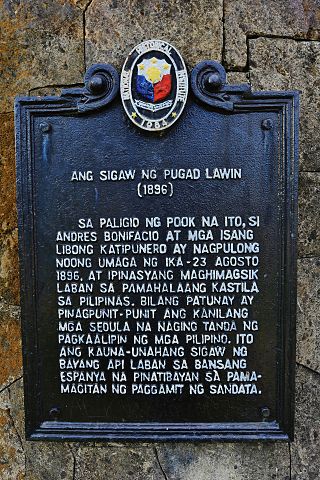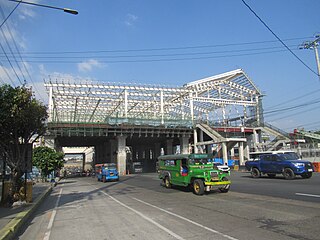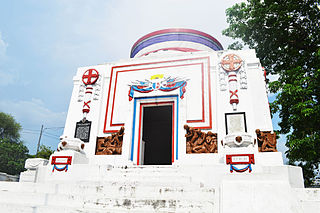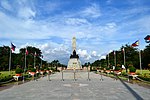
Melchora Aquino was a Filipino revolutionary. She became known as "Tandang Sora" because of her age during the Philippine Revolution.

Caloocan, officially the City of Caloocan, is a highly urbanized city in Metro Manila, Philippines. According to the 2020 census, it has a population of 1,661,584 people making it the fourth-most populous city in the Philippines.
A national hero of the Philippines is a Filipino who has been recognized as a national hero for their role in the history of the Philippines. Loosely, the term may refer to all historical figures recognized as heroes, but the term more strictly refers to those officially designated as such. In 1995 the Philippine National Heroes Committee officially recommended several people for the designation, but this was not acted upon. As of 2023, no one had ever been officially recognized as a Philippine national hero.

The Manila North Cemetery is one of the oldest cemeteries in Metro Manila, Philippines. The cemetery is owned by and located in the City of Manila, the national capital, and is one of the largest in the metropolis at 54 hectares. It is located alongside Andrés Bonifacio Avenue and borders two other important cemeteries: the La Loma Cemetery and the Manila Chinese Cemetery. Numerous impoverished families notably inhabit some of the mausoleums.

The Diocese of Novaliches is a diocese of the Latin Church of the Catholic Church in the Philippines. The diocese was created by Pope John Paul II on December 7, 2002, by virtue of his Apostolic Constitution Animarum Utilitati, and was canonically erected on January 16, 2003, from the Archdiocese of Manila. The diocese previously existed as the Ecclesiastical District of Quezon City-North, which was renamed the District of Novaliches in 2002.

The Roman Catholic Diocese of Cubao is a diocese of the western Latin Church of the Catholic Church in district of Cubao in Quezon City, in northern Metro Manila, Philippines. The diocese was created by Pope John Paul II on June 28, 2003 from the ecclesiastical district of Cubao of the Roman Catholic Archdiocese of Manila. It was canonically erected on August 28, 2003, with the installation of Honesto Flores Ongtioco as the first Bishop of Cubao. The Blessed Virgin Mary, under the title Immaculate Conception, is the principal patroness of the diocese.

Circumferential Road 5 (C-5), informally known as the C-5 Road, is a network of roads and bridges which comprise the fifth beltway of Metro Manila in the Philippines. Spanning some 43.87 kilometers (27.26 mi), it connects the cities of Las Piñas, Parañaque, Pasay, Pasig, Quezon City, Taguig, and Valenzuela.

The Cry of Pugad Lawin was the beginning of the Philippine Revolution against the Spanish Empire.

Tandang Sora station is an under-construction Metro Rail Transit (MRT) station located on the MRT Line 7 (MRT-7) system along Commonwealth Avenue in Matandang Balara and New Era, Quezon City.

Emilio Jacinto y Dizon was a Filipino general during the Philippine Revolution. He was one of the highest-ranking officers in the Philippine Revolution and was one of the highest-ranking officers of the revolutionary society Kataas-taasang, Kagalang-galang na Katipunan ng mga Anak ng Bayan, or simply and more popularly called Katipunan, being a member of its Supreme Council. He was elected Secretary of State for the Haring Bayang Katagalugan, a revolutionary government established during the outbreak of hostilities. He is popularly known in Philippine history textbooks as the Brains of the Katipunan while some contend he should be rightfully recognized as the "Brains of the Revolution". Jacinto was present in the so-called Cry of Pugad Lawin with Andrés Bonifacio, the Supremo of the Katipunan, and others of its members which signaled the start of the Revolution against the Spanish colonial government in the islands.

Katipunan Avenue is a major avenue in Quezon City, Metro Manila, Philippines. It runs north–south from the University of the Philippines Diliman, intersecting with Tandang Sora Avenue at its northernmost point, down to the Manila Philippines Temple of the Church of Jesus Christ of Latter-day Saints, intersecting with White Plains Avenue at its southernmost point.

The five-sentimo coin (5¢) coin is the second-lowest denomination coin of the Philippine peso after the one sentimo.

The Battle of Pasong Tamo was a series of short skirmishes shortly after the Cry of Balintawak between the remaining Katipuneros in Caloocan and the Guardia Civil.

Bonifacio: Ang Unang Pangulo is a 2014 Philippine historical action drama film centering on the life of Katipunan revolutionary Andres Bonifacio. It was an official entry to the 40th Metro Manila Film Festival.

National Route 129 (N129), or Route 129, is a secondary national route in Metro Manila that forms part of the Philippine highway network. Entirely located within Quezon City, it comprises Congressional Avenue, Congressional Avenue Extension, a portion of Luzon Avenue, a portion of Tandang Sora Avenue, and a portion of Katipunan Avenue; most of them are part of C-5 except the EDSA–Mindanao Avenue segment.

The Mausoleum of the Veterans of the Revolution is a memorial and national monument dedicated to Filipino revolutionaries of the Philippine Revolution of the 1890s and the Philippine–American War situated inside the Manila North Cemetery in Manila, Philippines.

Tandang Sora Avenue is a major east-west thoroughfare bisecting Quezon City in Metro Manila, Philippines. It is a two-to-six-lane highway and municipal road that runs for 9.6 kilometers (6.0 mi) from its eastern terminus at Magsaysay Avenue in Pansol and U.P. Campus in Diliman to its western terminus at Quirino Highway in Baesa and Talipapa in Novaliches, crossing Barangays Culiat, New Era, Pasong Tamo, Tandang Sora, and Sangandaan.

Supremo is a 2012 Filipino biographical film directed by Richard V. Somes about the life of Katipunan Supremo (President) Andrés Bonifacio. The film stars Alfred Vargas as Bonifacio, alongside Mon Confiado, Hermie Concepcion, Nicco Manalo, Alex Vincent Medina, Nica Naval, and Manu Respall. The film premiered at SM City Fairview in Quezon City on November 30, 2012, Bonifacio's 149th birth anniversary, and went into general release on December 5. It was also entered into competition at the 14th Cinemanila International Film Festival.
The C5 Metro Rail Transit Line 10, also known as MRT Line 10 or MRT-10, is a proposed rapid transit line in the Philippines. When completed, the line will be approximately 22.5 kilometers (14.0 mi) long, with 16 stations. The line would run along Circumferential Road 5, with a terminus at Ninoy Aquino International Airport, and another terminus in Commonwealth Avenue with a possible interchange with MRT-7 at Tandang Sora Station. The line would then run from Commonwealth Avenue through Katipunan Avenue, where there may be a possible interchange with LRT Line 2 at the Aurora Station in Katipunan Avenue. The line would then continue to NAIA along the aforementioned Circumferential Road 5. The planned location of the Line's Train Depot would be on UP Diliman Property in Diliman, Quezon City.

National Historical Shrines, more commonly known as National Shrines, are sites or structures in the Philippines that have been declared hallowed and revered due to their historical association to certain figures or events. Their designation are done by presidential decrees and executive orders, acts of congress and the National Historical Commission of the Philippines (NHCP).





















